Thinking about upgrading your plan to 50 Mbps? Wondering what you can do with 50 Mbps? Is it good enough for a family? Can you watch Netflix movies with 50 Mbps? Can you play online games? Read this article, and you will learn how fast 50 Mbps really is.
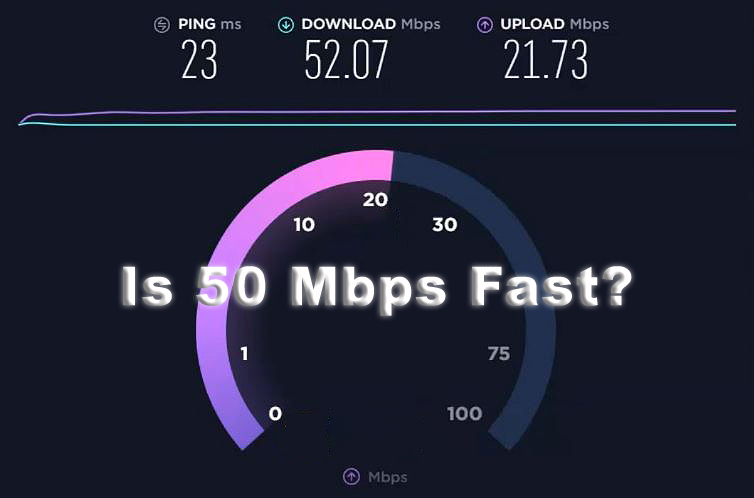
CONTENTS
- Internet Speed Explained
- Speed and Bandwidth – What’s the Difference?
- Units – Mbps and MB/sec (or MBps)
- The Same Internet Speed over Different Connection Technologies
- What is Broadband Internet?
- Broadband Internet Availability in the US
- Average Internet Speeds in the US
- Internet Prices in the US
- Digital Divide in the US – Reasons for High Prices, Low Speeds, and Poor Coverage in the US
- Is 50 Mbps Fast Enough?
- Verdict – Is 50 Mbps Fast or Not?
- FAQ
Internet Speed Explained
To get a better understanding of internet speeds in general, you need to know what some everyday speed-related terms mean.
Speed and Bandwidth – What’s the Difference?
Most internet users think that speed and bandwidth are the same thing since they are so often used Interchangeably. We tend to say that our internet is ‘faster’ if we have more Mbps. For example, 50 Mbps is faster than 35 Mbps, 35 Mbps is faster than 10 Mbps.
Surprisingly, speed and bandwidth are not synonyms. They don’t describe the same thing, even though we all use terms speed, faster, and slower when actually talking about bandwidth.
So, when we talk about our internet plans and Mbps, we are talking about bandwidth. Bandwidth is the measure of the maximum capacity of the internet connection. It’s the amount of data (10 Mb, 30 Mb, 50 Mb) that can be handled by the internet connection per unit of time (second).
Besides bandwidth, you should also know about throughput. It’s also the measure of capacity, but it’s not the max capacity – it’s a real-life capacity of your connection. Throughput is usually lower than bandwidth. Ideally, throughput and bandwidth will be equal.
When it comes to an internet connection, speed is basically the measure of latency. You can say that your connection is fast if the page starts loading the moment you press Enter. If you have to wait for the page to load, you can say that your connection is slow.
Units – Mbps and MB/sec (or MBps)
Both units are used to measure data rates, but they are not the same things. Mbps is Megabit per second, and MBps is Megabyte per second. Megabyte is 8x greater than Megabit, and MB/sec is 8x greater than Mbps. So, they are like inches and feet or gallons and barrels.
Mbps and MBps are used in different situations and for different purposes. Internet plans are advertised in Mbps (not MBps). Internet speed tests measure bandwidth in Mbps.
MBps, on the other hand, is used to measure data rate when downloading files or when transferring files from one folder to another.
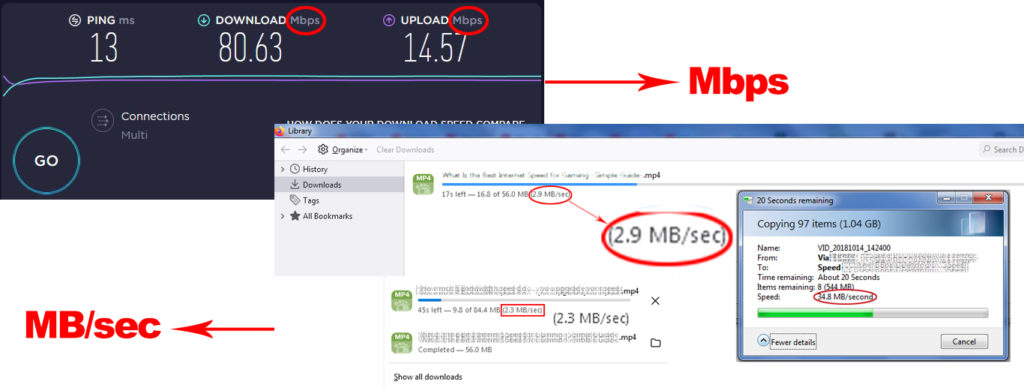
The Same Internet Speed over Different Connection Technologies
Is 50 Mbps over ADSL or satellite connection the same as 50 Mbps over fiber? No, they are not the same. Even though you get the same download speed, you won’t get the same upload speeds with every connection type and you won’t get the same performance because you won’t have the same latency and jitter.
So, if you can choose, your best option is fiber. It’s the only connection that offers symmetrical download and upload speeds. At the same time, it’s the connection with the lowest latency.
The cable can deliver Gigabit download speeds, just like fiber, but it delivers much lower upload speeds. Also, the latency is slightly higher.
ADSL, fixed wireless connection, and satellite connection can deliver much lower speeds than cable or fiber. Most ADSL and fixed wireless ISPs offer speeds up to 100 or 150 Mbps. Upload speeds never go over 20 Mbps. Latencies are also higher compared to cable and fiber. Satellite is, by far, the worst option, especially if you are a fan of gaming. The latency of satellite connection is much higher than the latency of any other connection type (usually above 500 or even 600ms).
Differences between various internet connection technologies (DSL, Cable, Fiber)
What is Broadband Internet?
Broadband internet, as defined by the FCC, is an internet connection that can deliver 25 Mbps download speed and 3 Mbps upload speed. So, you can’t consider just any internet connection a broadband connection. There are certain standards and benchmark speeds.
25/3 Mbps benchmark speeds were defined back in 2015. Before that, the benchmark speeds were 4 Mbps and 1 Mbps.
Many experts claim that benchmark speeds are too low by today’s standards, but the definition from 2015 is still in effect.
50 Mbps is twice as high as the broadband benchmark download speed, but does that mean that 50 Mbps is fast? You’ll find out soon.
Broadband Internet Availability in the US
Even broadband internet connection, which most of us consider too slow, is not available to every US citizen. According to the latest report on broadband internet deployment in the US, more than 14.4 million people in the US don’t have access to broadband speeds. The same report states that more than 7 million people don’t have access to speeds higher than 10/1 Mbps. All the data from the report dates from 2019, so it’s fair to assume that the situation has improved over the last two years. The new report will, hopefully, prove that.

The same report shows that 6.2% of the US population doesn’t have access to 50/5 Mbps. That’s 20.3 million people. So, more than 20 million people don’t have access to download speeds higher than 50 Mbps. From their perspective, 50 Mbps is quite fast.

While only 7.2 million people don’t have access to broadband speeds, the number of people who don’t use the internet at broadband speeds is much higher than that. Or at least was much higher back in 2020. According to Microsoft data, more than 120 million people in the US didn’t use the internet at broadband speeds back in 2020.
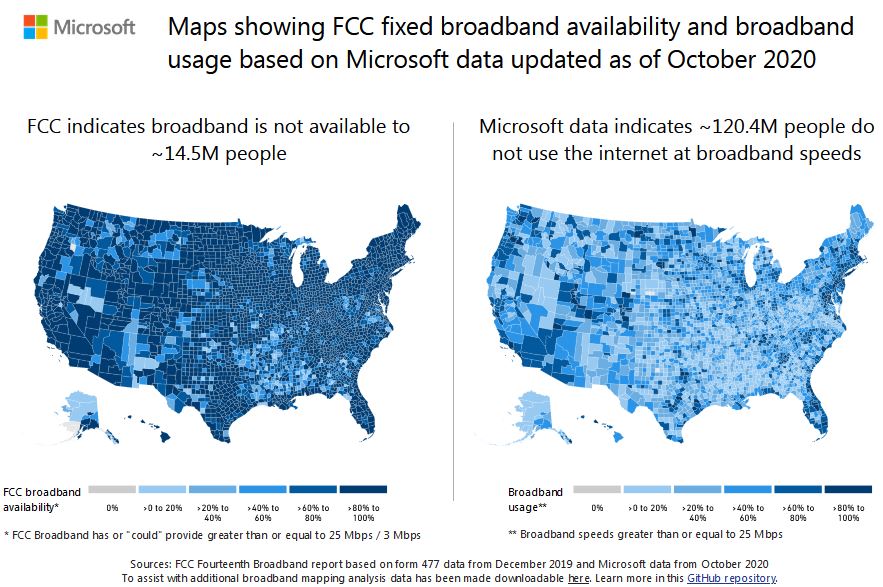
Hopefully, the number of people who don’t use the internet at broadband (or higher) speeds went under 100 million in 2021. The data is still not available for 2021.
Average Internet Speeds in the US
Since 2019, the situation with internet speeds has improved significantly. Up until 2017, we’ve had a moderate but constant increase in internet speeds. In 6 years (2011-2017), the average internet speed in the US increased by just 14 Mbps.
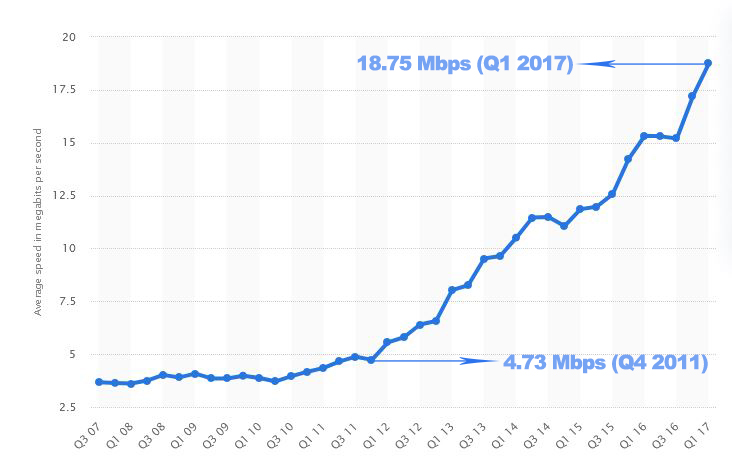
Average speeds in the US 2011-2017 (source – Statista)
In 2021, the average speeds in the US have finally reached 100 Mbps. So, in just four years (2017-2021), we’ve had an 80 Mbps increase.
Depending on the source, the average speeds in the US vary between 100 and 200 Mbps. Ookla SpeedTest, as the most popular speed test service, systematized speed test data and came up with an average download speed of 203 Mbps and an average upload speed of 74 Mbps. These speeds ranked the internet in the US as the 13th fastest in the world.
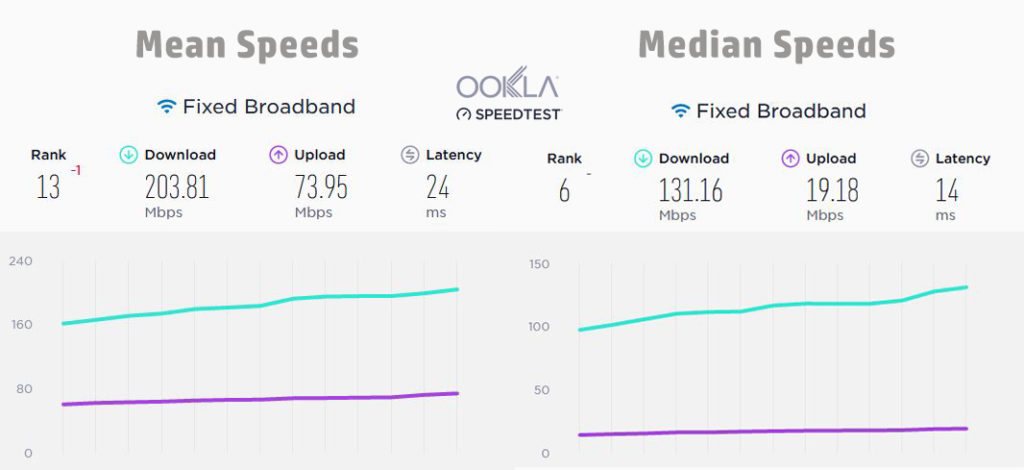
Such a huge increase in average speed was primarily caused by the expansion of fiber networks and Gigabit cable networks. Highspeed internet is now available to much more people than a few years ago. And it’s also cheaper.
The problem with the average speeds from the Ookla report is that they don’t really give us the most realistic picture. If you have 5 people and three of them are using the internet at a speed lower than 100 (let’s say 15, 30, and 100 Mbps), one is using the internet at 250 Mbps, and one is subscribed to Gig plan, their average speed is 279 Mbps. That’s why Ookla also gives us median speeds. They are lower (131/19 Mbps) and seem more realistic.
Internet Prices in the US
The average price of the internet in the US, as well as the price per Mbps, are among the highest in the world. The average fee that US citizens pay for their internet connection is $68/month, while the median is $50/month. The price per Mbps is $0.14.
The average monthly price of broadband internet connection is higher in the US than in Asia and Europe. The same goes for internet plans up to 100 Mbps.
The worst thing, when it comes to internet prices in the US, is the difference between average prices in rural and urban areas of the US. People in rural areas have to pay a lot more for lower speeds than people in urban areas. In many areas, they can’t get a high-speed internet connection. As explained in one of our previous sections, one quarter of the rural US doesn’t have access to speeds higher than 50 Mbps.
In the image below, you can see the AT&T example. People in rural areas can choose between DSL service and fixed wireless service. The speeds you can get over DSL range from 10 Mbps to 100 Mbps. The promotional price of each plan is $45/month. If you, on the other hand, live in a city and have access to AT&T fiber, you can get 500 Mbps for the same price.
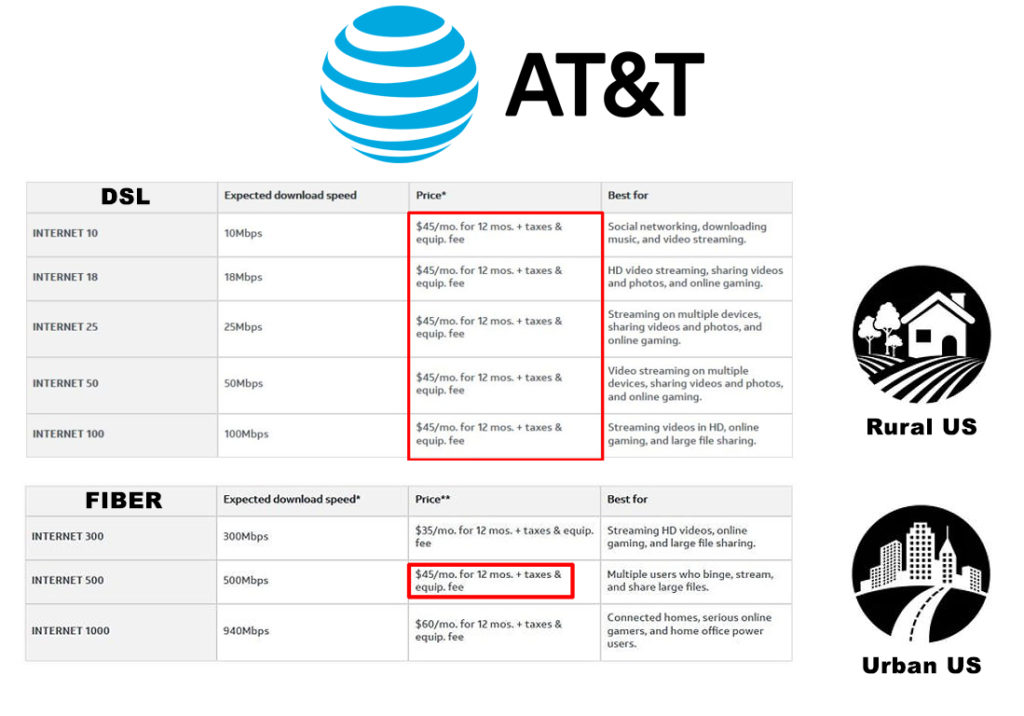
Digital Divide in the US – Reasons for High Prices, Low Speeds, and Poor Coverage in the US
As shown, the differences in price and available speeds between rural and urban US are quite significant. The reasons for such a divide are complex. Every ISP, especially those that operate in rural areas, will tell you that the costs of building new infrastructure in rural areas are high, while the population density is much lower than in urban areas. So, to make a profit, they have to charge more. These claims make sense, but only if they are actually building new infrastructure. In most cases, they are not building entirely new infrastructure – they are using the existing phone lines for DSL. If the population density is not ‘’satisfying’’ (big enough to provide a substantial profit), ISPs will not lay cables or fiber.
The biggest reason for such high prices in rural areas, at least in our opinion, is the lack of competition. Providers don’t feel the pressure to compete and win customers. They know that you can’t refuse their offer because there’s no other option. And so, they can charge you as much as they want.
Reasons for slow and expensive internet in the US
Is 50 Mbps Fast Enough?
50 Mbps is not that slow, but is it good enough for all your needs? Is it good enough for your entire family and all devices connected to your Wi-Fi? To answer these questions, we have gathered speed recommendations and minimum requirements from various sources.
Video Streaming, Gaming, Downloading at 50 Mbps
FCC Recommendations
We’ve already told you that FCC created the definition of broadband internet. They didn’t define those benchmark speeds arbitrarily. They did research first and established min required speeds for various activities. Then, they pinpointed the most demanding activities and decided that the benchmark broadband speed should match the min required speed for those demanding activities. Below, you can see the FCC recommendations.
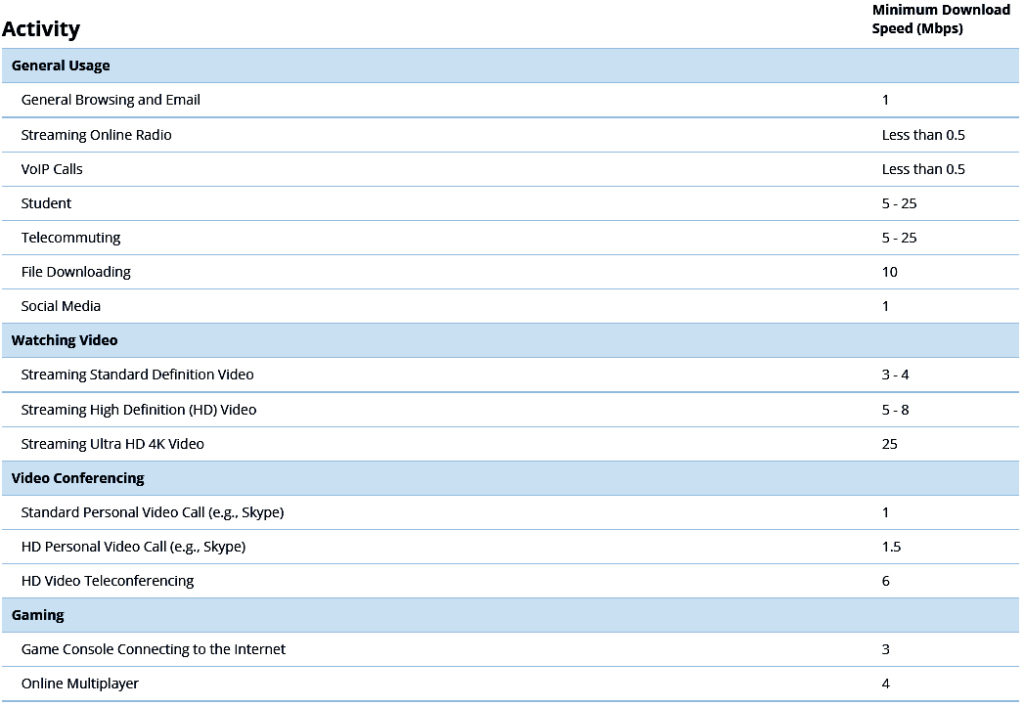
As the table shows, activities that demand the highest bandwidth are 4K streaming, working from home, and studying from home. They all require 25 Mbps. Hence, our broadband benchmark speed was set at 25 Mbps.
Is 50 Mbps Good for Video Streaming?
50 Mbps is good for any kind of streaming and any service you can think of. You can stream in 720p, 1080p, or even 4K. But depending on the service, you will be able to stream on a different number of devices at the same time. Why is that important? Well, it can tell you whether you need more than 50 Mbps for your entire household.
Let’s start with the most popular movie streaming service – Netflix. Netflix offers video content in SD, HD, and 4K. The recommended speeds are 3 Mbps, 5 Mbps, and 25 Mbps. So, with 50 Mbps, you can have 10 simultaneous HD streams or two 4K streams. In reality, you can actually have 3 simultaneous 4K streams since Netflix requires around 15 Mbps for 4K streams (most of the time). If you limit your video quality to 1080p, you can have 10 simultaneously connected devices and use them all for video streaming. Or you can have two or three simultaneously connected devices, and have 30 Mbps or 35 Mbps left for other activities.

YouTube has more video quality options than Netflix (144p to 8K). The requirements are similar to Netflix. The only significant difference is that you don’t need 25 Mbps for 4K – you need just 20 Mbps. So, you can have two simultaneous YouTube streams in 4K and two streams in HD (4 streams at the same time).

Amazon Prime Video and Hulu are probably the least demanding video streaming services when it comes to 4K content. Both services offer content in 720p, 1080p, and 4K. The requirements for Amazon Prime Video are 1 Mbps, 3.5 Mbps, and 15 Mbps, while Hulu requires, 3 Mbps, 6 Mbps, and 16 Mbps. With both streaming platforms, you can run three simultaneous 4K streams. If you are using Prime Video, you can have 14 simultaneous HD streams with 50 Mbps. Hulu has slightly higher requirements for HD videos – you can have 8 simultaneous HD streams.


Apple TV+, Disney +, and HBO Max require 5 Mbps for HD streams, the same as Netflix and YouTube. Disney+ and Apple TV+ also have content in 4K, which requires 25 Mbps. So, you can have at least two simultaneous 4K streams with 50 Mbps.



Is 50 Mbps Good for Audio Streaming?
Unlike movie/video streaming services, music streaming services, internet radio, and podcast streaming services are not too demanding. The required speeds for audio streaming are significantly lower – most audio streaming services require less than 500 kbps for the lowest streaming quality. If you want high-quality sound, you will need up to 3 Mbps. Some services (TIDAL, Apple Music, Amazon Music) will require up to 8 Mbps for lossless audio streaming.
So, if you want to stream music or listen to podcasts, you can have 20 (or even more) simultaneous streams with 50 Mbps.
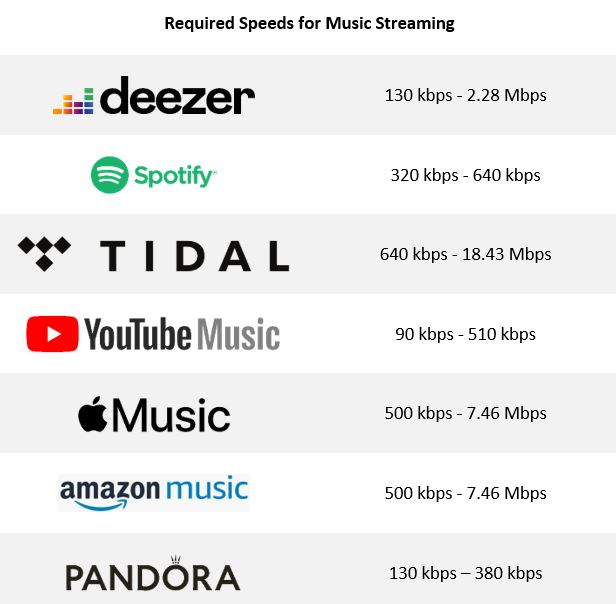
Is 50 Mbps Fast Enough for Gaming?
There are two types of online gaming. One is the old kind (aka traditional gaming). The other is cloud gaming, which is a new type that works in a different way and has different requirements.
Traditional gaming is what most of us still perceive as the only kind of gaming that actually works. You have your gaming PC or a console. The game is already installed on it. To play the game online, you need to connect to the right game server. The game is rendered on your machine, not on the server. The data exchanged between every player and the game server is not too large – you have information about the player position and status, control inputs, and communication between players. There’s no video streaming, and you don’t have to download/upload large files. So, traditional gaming is not a bandwidth-intensive activity. It doesn’t require crazy speeds. 3-4 Mbps download (and 1 Mbps upload), depending on the type of game, should be enough for a good gaming experience (assuming that other aspects of your internet connection are satisfying).

So, with 50 Mbps, you should be able to play any online game without problems. But you must never forget about other equally important aspects of your connection, primarily your ping, jitter, and packet loss.
Over the past few years, cloud gaming has become quite popular. It’s a different kind of gaming with different requirements and a different working principle. The best thing about it is that it eliminates the need for powerful gaming PCs. You can play your games on any device because the game is not rendered on your machine. The game server does all the processing and then streams video to your device. The worst thing about it is that you need much higher download speeds to receive the video from the server. Another bad thing about cloud gaming is that it consumes lots of data, which is something you must think about if your plan comes with a data cap.
The most popular cloud gaming services are Stadia, PS Now, Steam Link, Microsoft xCloud, Vortex, GeForce Now, etc. Most of them can only stream games in 720p and 1080p. With certain services (Google Stadia, Parsec, Moonlight), you can get video in 4K.

The required download speeds for different services vary depending on the video quality. Streaming in 720p requires up to 15 Mbps. In most cases, you will need just 10 Mbps. 1080p streaming requires 15-30 Mbps, while 4K streaming usually requires at least 45-50 Mbps.
So, with 50 Mbps, you can easily play in 720p and 1080p, while playing games in 4K can be tricky.
Playing Stadia games at various speeds (including 50 Mbps)
Is 50 Mbps Fast Enough for Video Conferencing?
Apps and services for video conferencing are not too demanding. Depending on the video quality you want to receive/send and the number of people (1-on-1 calls, group calls), the required download and upload speeds will be different.
Skype requires 1.5/1.5 Mbps for 1-on-1 HD calls and up to 8 Mbps download speed for group calls (7+ people). Zoom requires 3.8/3 Mbps for HD calls (both 1-on-1 and group calls).
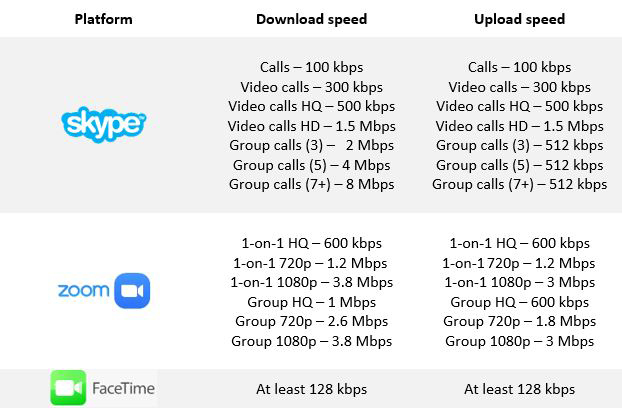
Is 50 Mbps Fast Enough for a Family?
Well, it’s not ideal, but it’s not like you can’t do anything with it. We would say that 50 Mbps is maybe good enough for 2 people and just a few connected devices (8 at best).
If you look at FCC’s household broadband guide, just a moderate use with 4 devices connected at the same time requires more than 25 Mbps.
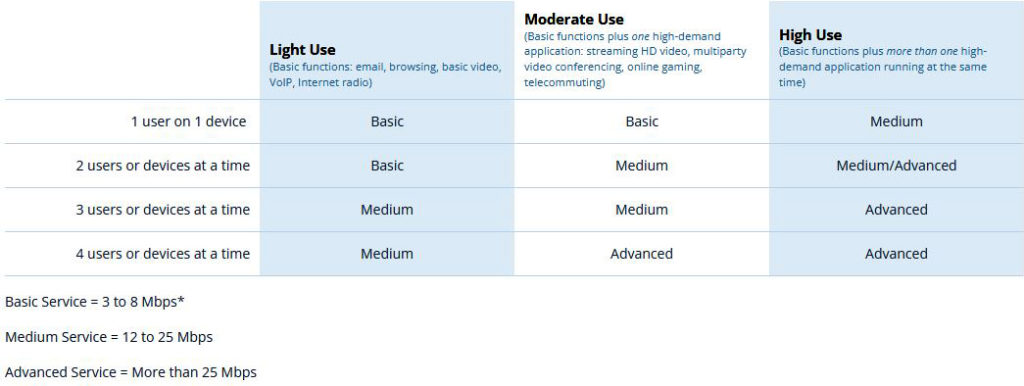
The problem with this guide is that we have so many connected devices in our homes – computers, smart TVs, phones, tablets, smart speakers, smartwatches, smart lights, even smart refrigerators. The number of connected devices in an average home exceeds 10. Some studies suggest that the number of Wi-Fi devices in an average household in the US is 25. Even if 90% of those devices consume up to 0.5 Mbps, 50 Mbps doesn’t seem enough. It’s not like you can’t plan your bandwidth consumption (download large files and do updates overnight), but you can hardly use your internet carefree.
Verdict – Is 50 Mbps Fast or Not?
50 Mbps is fast enough for almost any everyday online activity you can think of. You can check emails and your social media, listen to music, watch YouTube and Netflix in 4K, work and study from home, make and receive video calls, play online games. You can do anything you want, but not on multiple devices at the same time. For example, you can’t stream a 4K movie on one device, watch a 4K YouTube video on another device, download a file on a third device, and play Stadia games on a fourth device. That’s simply too much for 50 Mbps.
50 Mbps is not exactly slow, but you can’t do whatever you want with it. You have to think about your bandwidth use and avoid doing multiple bandwidth-intensive activities at once.
Below, you can see the estimated download times for files of different sizes. All download times are calculated under ideal conditions, assuming that the entire bandwidth is dedicated to the download process. In real life, when you have multiple connected devices, the download times will be longer.

FAQ
Q: Is 50 Mbps fast enough for Netflix?
A: Yes, 50 Mbps is fast enough for Netflix or any other video streaming service. The recommended speed for 4K Netflix streaming is 25 Mbps, which means that you can easily stream on two devices in 4K with 50 Mbps.
Q: Is 50 Mbps fast enough for gaming?
A: Assuming that your ping is satisfying (lower than 100 or 150ms), you can easily play any game with 50 Mbps. 50 Mbps is fast enough for both – traditional gaming and cloud gaming (in 720p or 1080p).
Q: Is 50 Mbps good for 2 devices?
A: We think it is. For the most demanding everyday activities (like 4K streaming), it’s recommended to have 25 Mbps per device. So, 50 Mbps should be ideal for two connected devices.
Q: Is 50 Mbps fast enough for YouTube?
A: Yes, it is. YouTube requires 5 Mbps for 1080p videos and 20 Mbps for 4K videos. With 50 Mbps, you can run 10 HD streams at the same time, or two 4K streams at the same time.
Q: What can you do with 50 Mbps speed?
A: You can do almost anything you can think of. Any activity that you do every day is possible with 50 Mbps. The only problem is that you can’t have multiple devices doing bandwidth-demanding activities at once.
Q: Is 50 Mbps good for Zoom?
A: Yes, 50 Mbps is fast enough for Zoom. Zoom requires just 3.8 Mbps download speed and 3 Mbps upload speed for HD calls.
Q: How much does 50 Mbps Internet cost?
A: The price of a plan that includes a 50 Mbps download will depend on the ISP, your location, and the connection type. Generally speaking, the promo prices range between $20/month and $50/month.

Hey, I’m Jeremy Clifford. I hold a bachelor’s degree in information systems, and I’m a certified network specialist. I worked for several internet providers in LA, San Francisco, Sacramento, and Seattle over the past 21 years.
I worked as a customer service operator, field technician, network engineer, and network specialist. During my career in networking, I’ve come across numerous modems, gateways, routers, and other networking hardware. I’ve installed network equipment, fixed it, designed and administrated networks, etc.
Networking is my passion, and I’m eager to share everything I know with you. On this website, you can read my modem and router reviews, as well as various how-to guides designed to help you solve your network problems. I want to liberate you from the fear that most users feel when they have to deal with modem and router settings.
My favorite free-time activities are gaming, movie-watching, and cooking. I also enjoy fishing, although I’m not good at it. What I’m good at is annoying David when we are fishing together. Apparently, you’re not supposed to talk or laugh while fishing – it scares the fishes.
